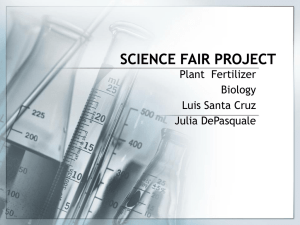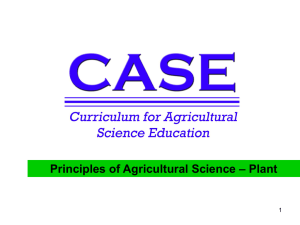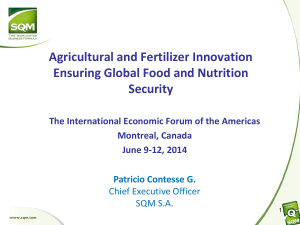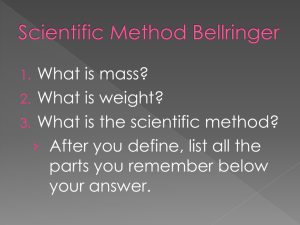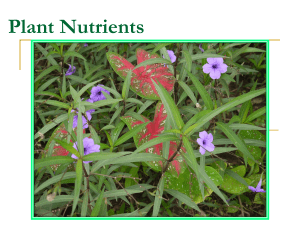Horticulture Science
advertisement
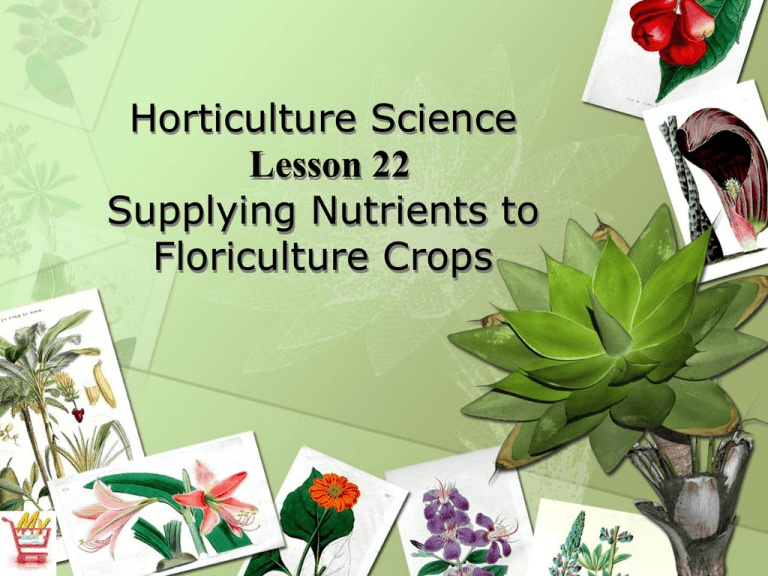
Horticulture Science Lesson 22 Supplying Nutrients to Floriculture Crops Interest Approach Lay out several examples of fertilizers. Pick a flowering plant and ask the students to find the correct fertilizer for that particular plant. Ask them why they chose that fertilizer. Repeat this activity with a houseplant and a vegetable plant. Then ask the students to describe how they would use the fertilizer (e.g., mix with water, apply to the soil, spray on the leaves). Finally, ask the students to describe what is in the fertilizer that helps plants grow. Student Learning Objectives •Discuss plant nutrition. •Describe pH and how it is modified. Student Learning Objectives •Describe the components of a fertilizer. •Explain the methods of applying fertilizers to horticultural crops. Terms • • • • • • • • • chlorosis complete fertilizer fertilizer fertilizer analysis fertilizer injector systems incomplete fertilizer limestone macronutrient micronutrient • • • • • • • • • • Terms nutrient deficiency parts per million (ppm) plant nutrition primary macronutrients secondary macronutrients slow release fertilizer soil pH soil test sulfur water-soluble fertilizer What is plant nutrition? • Plants need nutrients for healthy growth and development. • Plant nutrition involves the absorption of nutrients for plant growth and is dependent on 16 essential elements, often referred to as nutrients. What is plant nutrition? • Three of the 16 elements comprise 89 percent of a plant’s tissue by dry weight: oxygen (O), hydrogen (H), and carbon (C). • They are considered to be non-fertilizer nutrients. • The plant acquires these three elements through natural processes from air and water. What is plant nutrition? Six essential elements in addition to oxygen, hydrogen, and carbon are required in greater quantity than the others; they are called macronutrients. • The macronutrients are nitrogen (N), phosphorus (P), potassium (K), calcium (Ca), magnesium (Mg), and sulfur (S). – 1. Nitrogen, phosphorus, and potassium are considered primary macronutrients because they are used in complete fertilizers. • Nitrogen promotes green leafy growth. • Phosphorus encourages flowering and root growth. • Potassium provides disease resistance. What is plant nutrition? – 2. Calcium, magnesium, and sulfur are said to be secondary macronutrients because plants need them in moderate amounts. • These secondary macronutrients may or may not be used in complete fertilizers. What is plant nutrition? • The other seven essential elements, called micronutrients, are needed in small quantities. • These are sometimes called trace elements. They are boron (B), copper (Cu), chlorine (Cl), iron (Fe), manganese (Mn), molybdenum (Mo), sodium (Na), and zinc (Zn). • Six of these (boron, copper, iron, manganese, molybdenum, sodium, and zinc) are supplied to plants as fertilizers. • Chlorine is not added to fertilizers since plants obtain sufficient quantities of chlorine from the medium or from water. What is plant nutrition? A little phrase can be used to help memorize the 16 essential elements for plant growth. – It is “C. B. Hopkins Café Mighty Good Closed Monday See You Zen.” • It represents the following: Carbon (C), Boron (B), Hydrogen (Hopkins), Oxygen (HOpkins), Phosphorus (HoPkins), Potassium (HopKins), Nitrogen (HopkiNs), Sulfur (HopkinS), Calcium (Café), Iron (café), Magnesium (Mighty good), Chlorine (Closed), Manganese (Monday), Molybdenum (Morning), Copper (See you = Cu), Zinc (Zen). What is plant nutrition? • Other elements play important roles in plant growth and development. • For instance, silicon (Si) improves plant strength and disease resistance. • Nickel (Ni) is another element considered important for plant growth. What is plant nutrition? • Plants receive most of the nutrients they need from the growing media. • In order to maintain healthy plants, a grower must provide the right type and amount of nutrients to the media so the plants can absorb the nutrients and grow. – 1. A soil test can be performed to determine which nutrients are present and which nutrients are deficient or lacking. – 2. When nutrients are deficient in the soil, the plant growth is adversely affected. What is plant nutrition? • It is common for plant leaves to show symptoms of a nutrient deficiency by turning colors. • When nitrogen is deficient in the soil, a plant’s older leaves turn yellow. • Abnormal yellowing of plant leaves is a condition called chlorosis. • A plant will show purpling in the stem or leaf when phosphorus is deficient. What is pH and how is it modified? • Many times, the nutrients needed for plant growth are present in the soil, but the plants do not have access to the nutrients. • Nutrient availability is influenced by the pH of the soil. • Soil pH measures the amount of acidity or alkalinity and is based on the amount of hydrogen ions present in the soil. What is pH and how is it modified? • Soil pH can range from 1 to 14. • A pH reading of 7 is neutral. • Substances that have pH readings below 7 are acidic. • Substances with pH readings above 7 are alkaline or basic. What is pH and how is it modified? • Plants have specific pH ranges that are ideal for maximum plant growth. • Most plants grow best at a pH of 5.5 to 7 because the most nutrients are available for the plant to absorb in that range. • Some important horticultural plants (azaleas) do better in a medium that has a more acidic pH. What is pH and how is it modified? • A soil test can be performed to determine the pH of the soil, and amendments can be added to modify the pH. • Limestone is commonly added to growing medium in order to raise the pH. • Sulfur or sulfur compounds can be added to the media to lower the pH. What are the components of a fertilizer? • A fertilizer is any material added to growing medium that provides nutrients for plants. • Fertilizers vary in the components they contain, the way they are applied, and the function they serve. What are the components of a fertilizer? • When choosing a fertilizer, one should always look for the fertilizer analysis on the bag or box. • The fertilizer analysis states the percentage of primary nutrients (nitrogen, phosphate, and potash) present in the fertilizer. • The analysis is written as three numbers (i.e., 1510-26), which represent the percent of nitrogen, phosphorus, and potash present in the fertilizer. • They are always listed in that order. What are the components of a fertilizer? • Fertilizer analysis What are the components of a fertilizer? • If a fertilizer contains all three primary nutrients, it is called a complete fertilizer. • If a fertilizer is lacking any of the three primary nutrients, it is an incomplete fertilizer. – The fertilizer analysis does not equal 100%. – The rest of the fertilizer composition consists of filler materials (necessary for the fertilizer to be applied) and possibly some micronutrients. How are fertilizers applied to horticultural crops? • Different plants have different nutrient requirements; some are heavy feeders and others are light feeders. How are fertilizers applied to horticultural crops? Plants have different nutrient requirements based on the stage of growth. – The first stage is when the plant is a young seedling or cutting. – In the second stage, vegetative or leafy growth is encouraged. How are fertilizers applied to horticultural crops? – This is followed by the flower bud initiation stage, the flower bud development stage, and the flowering stages. – Each stage calls for different rates of fertilizers. – In the vegetative stage, plants use more nitrogen, whereas the flowering stage requires less nitrogen and more phosphorus. How are fertilizers applied to horticultural crops? • Fertilizers are typically applied as watersoluble fertilizer or as slow-release fertilizers. 1. Water-soluble fertilizers dissolve completely in water and stay in solution. – The concentrations of the water-soluble fertilizers are also easily adjusted. – The fertilizer concentrate is then mixed with the water in exact proportions before irrigating plants. How are fertilizers applied to horticultural crops? • Fertilizer injector systems are standard equipment in today’s greenhouses. • With fertilizer injector systems, growers can provide exact levels of water-soluble fertilizers to a crop. How are fertilizers applied to horticultural crops? 2. Slow-release fertilizers continually discharge a small amount of nutrients into the growing media over a period of time. – They are available in two forms. – One form consists of a water-soluble fertilizer held within a plastic resin or sulfur coating and is designed to allow a small amount of fertilizer to be slowly released; they have the appearance of little round beads and are sometimes mistaken as insect eggs by the uninformed. How are fertilizers applied to horticultural crops? – The other type of slow-release fertilizer comes in a granular form. – This type releases no more than one percent of the fertilizer in a 24-hour period. How are fertilizers applied to horticultural crops? • There are a number of advantages to using fertilizer injectors. • The greenhouse plants are provided with constant liquid feeding, which is especially important with soilless media that have a low cation-exchange capacity. • The plants are fertilized when they are watered, thus reducing labor. How are fertilizers applied to horticultural crops? • All the plants of a particular crop receive the same levels of nutrients, which assists in producing a uniform crop. • In addition, adjustments to the level of nutrients in solution can be made easily. How are fertilizers applied to horticultural crops? • Nutrients in solution are measured in parts per million or PPM. • Fertilizer rates can be taken from tables in reference books or to instructions with their injector system, or growers can calculate the amount of fertilizer needed to reach a desired PPM. • In either case, it is beneficial for a grower to understand how to calculate parts per million (PPM) of fertilizer nutrients. How are fertilizers applied to horticultural crops? 1. An example problem might call for 200 PPM nitrogen. • The chosen fertilizer is calcium nitrate with an analysis of 15-0-0. • A rule of thumb in calculating PPM is that 1 ounce of anything in 100 gallons H2O equals 75 PPM. How are fertilizers applied to horticultural crops? • Problem: Wanted, 200 PPM N 15-0-0 Calcium Nitrate – Multiply the percent of the nutrient in the given fertilizer by 75. – .15 N × 75 = 11.63 PPM N (if 1 oz added to 100 gallons) 200 divided by 11.63 = 17.2 oz of fertilizer needed in 100 gallons to get 200 PPM. How are fertilizers applied to horticultural crops? • If the injector system delivers 1:100 (one gallon concentrate mixed with 99 gallons water for a total of 100 gallons), 17.2 ounces of fertilizer is needed for each gallon of concentrate. • If the tank holds 30 gallons of concentrate, 516 ounces (32.25 pounds) of fertilizer is needed to deliver 200 PPM. Review/Summary •What is plant nutrition? •What is pH and how is it modified? Review/Summary •What are the components of a fertilizer? •How are fertilizers applied to horticultural crops?

